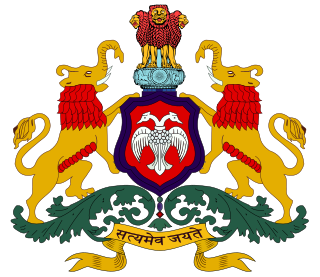
The Government of Karnataka, abbreviated as GoK, or simply Karnataka Government, formerly Government of Mysore, is a democratically elected state body with the governor as the ceremonial head to govern the Southwest Indian state of Karnataka. The governor who is appointed for five years appoints the chief minister and on the advice of the chief minister appoints his council of ministers. Even though the governor remains the ceremonial head of the state, the day-to-day running of the government is taken care of by the chief minister and his council of ministers in whom a great amount of legislative powers are vested.
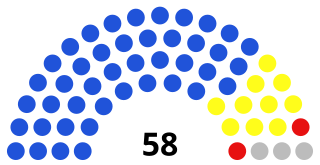
The Andhra Pradesh Legislature is the state legislature of the Indian state of Andhra Pradesh. It follows a Westminster-derived parliamentary system and is composed of an
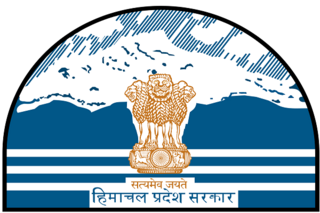
The Government of Himachal Pradesh also known as the State Government of Himachal Pradesh, or locally as State Government, is the supreme governing authority of the Indian state of Himachal Pradesh. It consists of an executive branch, led by the Governor of Himachal Pradesh, a judiciary and a legislative branch.
The Government of Uttar Pradesh is the subnational government of the Indian state of Uttar Pradesh with the governor as its appointed constitutional head of the state by the President of India. The Governor of Uttar Pradesh is appointed for a period of five years and appoints the Chief Minister of Uttar Pradesh and their council of ministers, who are vested with the executive powers of the state. The governor remains a ceremonial head of the state, while the chief minister and their council are responsible for day-to-day government functions.

The Government of Bihar or Bihar Government is the state government of the Indian state of Bihar and its nine divisions which consist of 38 districts. It consists of an executive, led by the Governor of Bihar, a judiciary and legislative branches.
The Government of Arunachal Pradesh or Arunachal Pradesh Government, abbreviated as GoAR, is the state government of the Indian state of Arunachal Pradesh. It consists of an executive, led by the Governor of Arunachal Pradesh, a judiciary and a legislative branch.

The Government of Gujarat, also known as GujaratGovernment, is the supreme governing authority of the Indian state of Gujarat and its 33 districts. It consists of an executive of the legislators appointed by the Governor of Gujarat, a judiciary and of a publicly elected legislative body.
Government of Madhya Pradesh also known as the State Government of Madhya Pradesh, or locally as the Madhya Pradesh Government, is the supreme governing authority of the Indian state of Madhya Pradesh and its 55 districts. It consists of an executive, led by the governor of Madhya Pradesh, a judiciary and a legislative branch. In 2000, the southern portion was broken off to form the new state of Chhattisgarh with its own government.

The Andhra Pradesh Legislative Assembly or Āndhra Pradēś Śāsana Sabha is the lower house of the bicameral legislature of the Indian state, Andhra Pradesh.

Konijeti Rosaiah was an Indian politician who served as the 15th chief minister of Andhra Pradesh from 2009 to 2010. He also served as the Governor of Tamil Nadu from 2011 to 2016 and the Governor of Karnataka for two months. He was previously an MLC, MLA and MP from the Indian National Congress numerous times and handled many ministerial posts over his long political career spanning over half a century.
State governments in India are the governments ruling over 28 states and 8 union territories of India and the head of the Council of Ministers in a state is the Chief Minister. Power is divided between the Union government and state governments. While the Union government handles defence, external affairs etc., the state government deals with internal security and other state issues. Income for the Union government is from customs duty, excise tax, income tax etc., while state government income comes from sales tax (VAT), stamp duty etc.; now these have been subsumed under the various components of the Goods and Services Tax
Thaneeru Harish Rao is an Indian politician and Member of Legislative Assembly (MLA) of Telangana Legislative Assembly. He previously served as the Minister of Medical - Health and Finance Department of Telangana from 08 September 2019 to 02 December 2023. He is the MLA from Siddipet constituency from the Bharat Rashtra Samithi party since 2004.
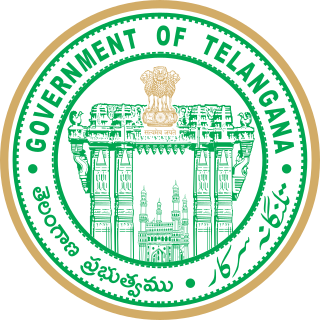
The Government of Telangana also known as TelanganaGovernment, is the governing authority of the state of Telangana in India. It consists of an executive, a judiciary and a legislative.

The Emblem of Andhra Pradesh serves as the official state emblem of the Indian state of Andhra Pradesh.

The 2015 cash-for-votes scam was a political scandal in India, the second scandal of its kind since the 2008 cash-for-votes scandal. The 2015 political scandal started off when the Telugu Desam Party (TDP) leaders of Telangana state were caught in a video footage, aired in the media, offering bribes to a nominated MLA, Elvis Stephenson, for his vote in the 2015 elections of the Telangana Legislative Council. The TDP MLA Revanth Reddy was arrested by the Telangana Police when he was offering Rs. 50 lakhs to Stephenson. Reddy was then presented before the court and was sent to jail. Similarly, with N. Chandrababu Naidu, the then Andhra Pradesh Chief Minister, with Stephenson was aired in the news media.
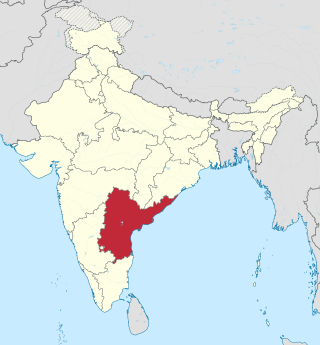
Andhra Pradesh, retrospectively referred to as United Andhra Pradesh, Undivided Andhra Pradesh or Ummadi Andhra Pradesh, was a state in India formed by States Reorganisation Act, 1956 with Hyderabad as its capital and was reorganised by Andhra Pradesh Reorganisation Act, 2014. The state was made up of three distinct cultural regions of Telangana, Rayalaseema, and Coastal Andhra. Before the 1956 reorganisation, Telangana had been part of Hyderabad State ruled by Nizam of Hyderabad, whereas Rayalaseema and Coastal Andhra had been part of Andhra State, formerly a part of Madras Presidency ruled by British India.
The Andhra Pradesh Decentralisation and Inclusive Development of All Regions Act, 2020 is an act of Andhra Pradesh Legislature aimed at the decentralisation of governance in the Indian state of Andhra Pradesh. The bill was proposed by the Government of Andhra Pradesh to establish three capitals at different places in the state namely Visakhapatnam, Amaravati, and Kurnool, which will serve as executive, legislative and judicial capitals respectively.
The Andhra Pradesh Council of Ministers are elected legislative members, who are appointed as ministers by the Governor of Andhra Pradesh to form the executive branch of the Government of Andhra Pradesh. They hold various portfolios as decided by the Chief minister of Andhra Pradesh. The current state council of ministers is headed by Y. S. Jagan Mohan Reddy after the 2019 Andhra Pradesh Legislative Assembly election. The term of every executive wing is for 5 years.












